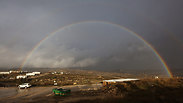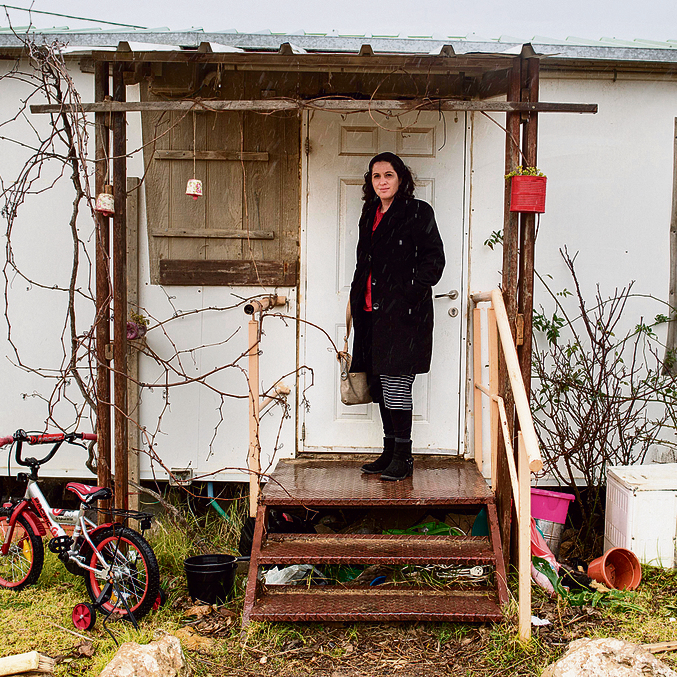
This used to be my home
Op-ed: A day before the Amona evacuation, Yifat Erlich pays a last visit to the modest caravan that she first entered as a newlywed 18 years ago and in which she raised three children.
I didn’t want to live in a caravan. I came to Amona, to a bald and wind-battered rocky mountain, to establish a permanent community, to build a stone house. I only dared build a home after then-prime minister Ariel Sharon encouraged me to do so in a personal meeting. “Why don’t you build in Amona?” he scolded me. “Build already. Wherever you build you will stay,” the prime minister promised. So we built.
We chose to build the permanent home as close to the caravan as possible. At the spot with the most beautiful landscape, at the edge of the mountain over the green wadi. In the background one can see the homes of Ofra, creating red dots on the mountain, and far on the horizon, between the sky and the mountain—Jerusalem and Herodium. We paid a heavy price for the pastoral landscape at the window of the house—a strong, whirling wind.

And then the bulldozers came exactly 11 years ago and destroyed the house. And destroyed the dreams. And left a wound in my heart.
I didn’t want to live in a caravan on blocks. I wanted a permanent home with roots in the ground. So we bid farewell to the caravan on the mountain and went down to become bourgeois in a permanent home in Ofra.
I went up to Amona many times: to visit friends, to breathe some fresh air and smell the landscape, but for years I wouldn’t dare enter the caravan that used to be my home. The wound had turned into a scar. I was afraid to scratch it.
On Tuesday, I went up to say goodbye. At the entrance, I was greeted by the fig tree, the one we planted in the garden. The years have been kind to it, thickened its trunk and elevated its treetop. It stood naked in the rain, trembling in the wind. I trembled along with it.
The caravan that used to be my home now accommodates the S. family. Just as I arrived, the three children were being put in the car. Their mother drove them out of Amona, to their grandparents’ home in a nearby community. Children should not have to see their home being demolished. Adults shouldn’t either. I am talking from bitter experience. Eleven years ago, I saw the walls of my dreamhouse collapse before my eyes. In the caravan yard, I see a monument of stones and twisted iron from those walls. For what purpose were they destroyed back then? Did anyone in the world benefit from it? What’s the point in an incomprehensible demolition?
A soft knock on the door, and I enter. Inside the caravan, the past smiles at me, stirring up sweet memories, clawing at me from the inside. The S. family has yet to pack its belongings. The laundry is drying in the hallway, and potatoes are turning gold in the oven. A smell of home. A home that, in a few hours, will turn into a non-home. A community that has existed for 20 years will turn, in a few hours, into ruins. And the destruction is spreading. In several days, nine permanent homes in Ofra, just one block away from my current home, will be ruined.
And the heart cries out: For what purpose? In the name of what? Is there no way to solve the Amona mess without uprooting people from their homes? Can’t the land owners be compensated? Can’t land be expropriated—like in any other area in the State of Israel—in favor of an existing community?
It was a mistake to establish Amona and parts of Ofra on lands registered as private lands, although no one ever lived on them. A mistake cannot be fixed with a bigger mistake. Not to mention the fact that the land owners did not even know that the land had been registered on their name, if it were not for the Yesh Din organization which went to the trouble of locating them.
The pioneers who came to the mountain made it flourish and put down roots. Israel’s governments in the past 20 years pushed and funded the community’s expansion. In Ofra too, the nine homes were connected to infrastructures by the Israeli government, a government that failed to protect the pioneers at the High Court. The most right-wing government in history is evacuating a community in the Land of Israel and demolishing permanent homes in Ofra—the flagship community of Judea and Samaria. This accomplishment will forever have Benjamin Netanyahu and Naftali Bennett’s name on it.
With the first light of day, the bulldozer will destroy the mountain, swallow the memories and claw at hearts. And at dawn, a new day will begin with an old-new hope. Pioneers don’t break down. They always get up and climb the mountain again. The fig tree will be waiting for them there, upright and noble, ready to greet them.










